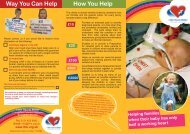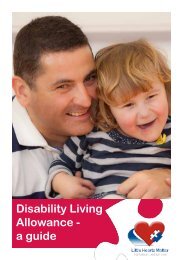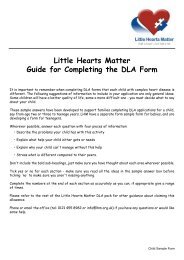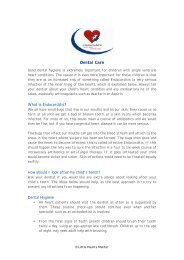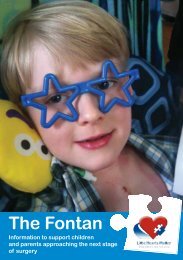MedicalThe article below looks at the emotional rollercoaster of futurepregnancies after having gone through the diagnosis ofhaving a child with a single ventricle heart condition.If you have had a child affected by acomplex heart problem, the thought offuture pregnancies will inevitably be ascary prospect. Making the decisionwhether to try again is a complex one,coloured by the painful memories ofwhat happened in the previouspregnancy or at birth when thediagnosis of a cardiac defect wasmade.For those parents who chose to endthe pregnancy or whose baby diedafter birth or whilst undergoingtreatment, t<strong>here</strong> can be a conflictbetween treasuring the memories ofthe baby who died and the hopes ofhaving a healthy child.Although we know from researchand experience that if you have had achild with a congenital heart defect,t<strong>here</strong> is a small increased risk in futurepregnancies, by far the most likelyoutcome is that you will have a childwith a normal heart.Your own individual recurrence riskwill be given to you by your medicalteam, but the range could be anythingfrom 2-3% to 9-10%. The factorsinfluencing this include the exact natureof the condition your previous child hadOur StoryWritten byRuth Kirchmeier, Birmingham Women's HospitalSherrida Rollings, Guy's and St Thomasand your individual family background.However it may help to bear in mindthat even if the recurrence risk is 10%, itmeans that you have a 90% chance ofyour baby's heart being normal nexttime, and even if t<strong>here</strong> is a problem itwould not necessarily be the same, oras severe, as your previous child.Whilst statistics such as these aregiven to reassure you and help youmake plans for the future, we knowthat when you have had a child with acongenital heart condition, it is hard tobelieve that it will not happen again.Preconception CareMost parents will want to know if t<strong>here</strong>is anything they can do to reduce therisk of recurrence. Whilst as yet, thecauses of single ventricle heart diseaseare not known t<strong>here</strong> are a few simplethings that parents can do to keepthemselves healthy and t<strong>here</strong>fore givetheir baby the best chance.Eat a good balanced diet includingfoods rich in Folic Acid, e.g. fruits,green leafy vegetables, lentils,chickpeas, some cereals and bread.Cut down on the intake of caffeine toreduce the risk of miscarriage.Reduce and if possible stop smokingprior to conception. Smoking can affectthe fertility of both men and womenand may mean it takes longer toconceive.Reduce and if possible stop drinkingalcohol prior to conception. Alcohol toocan affect both men's and women'sfertility.Take 400 micrograms of Folic Acidonce a day ideally for three monthsprior to conception and for the firsttwelve weeks of the pregnancy. This isthought to reduce the risks of neuraltube defects such as spina bifida.Exercise regularly to maintain areasonable level of fitness.Facing the emotional impact of afurther pregnancyNo one can take away the anxietywhich the thought of a future pregnancybrings.Sometimes it might be helpful forparents to see their obstetrican or GPprior to embarking on a pregnancy, totalk through some of the issuessurrounding how a subsequentpregnancy would be managed andwhat support could be given. For someparents, making a decision to try againcan be helped by talking to otherparents who have had an affectedchild and who have had a furthersuccessful pregnancy. <strong>Little</strong> <strong>Hearts</strong><strong>Matter</strong> can put parents in touch withone another and these contacts can bevaluable sources of support both priorand during a pregnancy.The booking scanThe booking scan, usually carried outby about 12 weeks of pregnancy, willhopefully be a positive affirmation thatso far all is well and the first hurdle ofearly miscarriage is past. Seeing thebaby on the screen can bring a mixtureof emotions as hopes and aspirationsfor this new baby combine withmemories of scans in the previouspregnancy.Further routine screening tests willbe offered to look for the risk of Down's6Lynne and Caryshad always wanted three children butI after our second daughter, Carys,was born with a single ventriclecondition, I started to think it wouldnever happen. To start with, t<strong>here</strong> wasso much else to think and worry about.I wanted to get her three operationsover with before thinking about gettingpregnant again. I did not want to becoping with a pregnancy at the sametime as a big op. We were expectingthe Fontan at about three years old butin the end she was nearly five beforehaving it.Then t<strong>here</strong> was the risk of ithappening again – it was hard to trustin my body’s ability to nurture andgrow a healthy baby (even though Ihad managed it once with Hannah). Ihad times when I was focused on thestatistical risk (which was fairly small)but other times (often in the wee smallhours) when I was terrified of the riskwe might be taking with this as yet notconceived new person.Over the years we had had supportfrom the medical team – we had visitedthe fetal medicine specialist to get anassessment of our risk factors whenCarys was two or three and this hadbeen a very useful session (althoughvery uncomfortable being back in theunit w<strong>here</strong> Carys’ problems were firstdiagnosed).It finally took us over seven years tomake the decision to try for anotherbaby. Once the blue line appeared wethen entered an anxious nine monthswait. The local obstetricians were verysupportive – the doc who did ourgenetic testing in early pregnancy alsothrew in a quick nuchal translucency
syndrome and throughout pregnancy,the general size and growth of thebaby will be assessed.All parents of a child with a congenitalheart condition should be given theopportunity to have a specialist fetalcardiology scan if they want one. Thiscan be arranged as part of the bookingprocess.How early in pregnancy can heartabnormalities be detected?Unfortunately congenital heartconditions can only be detected bydetailed ultrasound scan andtraditionally scanning in pregnancy forthe detection of heart abnormalitieshas been around 20 weeks ofpregnancy when the heart is the sizeof a walnut.As scanning technology and expertiseof those carrying out the scans hasimproved, it is now possible in somefetal medicine centres to offer an initialheart scan at around 14 weeks.Clearly for parents who have had apreviously affected child, anyreassurance which can be given earlierin pregnancy is beneficial. Parentswould need to talk to their obstetricianto find out whether early cardiac scansare available in their area.What can be detected at thisearly scan?The heart at 14 weeks is about the sizeof a pea and t<strong>here</strong>fore it is not possibleto visualise all the structures in theheart in sufficient detail to reassureparents that the heart is completelynormal but it is possible to detect majorabnormalities. The team will also lookfor other indications that the baby mayhave a problem for example, thenuchal translucency - fluid filled spaceat the back of the baby's neck (seebelow).If all of the tests are normal it is likelythat the heart will be normal although afurther scan will be arranged around20 weeks for added reassurance.Why is a measurement of thenuchal translucency carried out?It is known that t<strong>here</strong> is an increasedrisk of the baby having a heartabnormality if the measurement of thenuchal translucency is larger than itshould be for the number of weeks ofpregnancy.An increased nuchal translucencymeasurement is also a marker ofincreased risk of chromosomeabnormalities such as Down'ssyndrome. If this was found to be thecase, the clinician would discuss withparents whether they would like furthertests to check whether the baby'sgenetic make-up is normal.What happens if an abnormalityis found?In the rare case that the fetal medicalteam detect or suspect that t<strong>here</strong> is aproblem with the structure or functionof the heart they will organise forfurther scanning and other tests to beconducted.Throughout the process expectantparents will be involved in discussionsabout the baby and any treatment paththat is suggested for the baby andmother's care.What other tests are offered inpregnancy?If t<strong>here</strong> are indications that t<strong>here</strong> maybe an abnormality in the heart, otherorgans, growth or development of thebaby, further diagnostic tests will beoffered to obtain additional informationabout the baby's genetic make up.Chorionic Villus Sampling takes asample from the developing placentaand is carried out at around 11 weeks.The procedure carries a risk ofmiscarriage of about 1 in 75 and thefirst part of the result (the PCR test)looking at the three more commonchromosome differences whichincludes Down's syndrome initialresults are usually available in 3 - 4days. The full results are usuallyavailable within three weeks.Amniocentesis takes a sample ofamniotic fluid from around the babyand is carried out at around 15 - 16weeks. The risk of miscarriage is about1 in 100 - 150 and the first part of t<strong>here</strong>sult (the PCR test) looking at thethree more common chromosomedifferences which includes Down'ssyndrome, is usually available in 3 - 4days. The full results take 2 - 3 weeks.It is very important that parents aregiven adequate opportunities to askquestions and voice their concernswith their doctors or midwives so thatthey ultimately feel comfortable withthe decisions they make.Whichever antenatal tests parentschoose, waiting for the results will bean anxious time. Many parents chooseto wait until they have had t<strong>here</strong>assurance of a normal result beforetelling other people about thepregnancy and this can be quite astrain, particularly if they have optedfor a later test.It is important to remember that mostfuture pregnancies will have nocomplications and most importantlythat the new baby will be born withoutany problems.The rest of the pregnancyMost parents who have had previousproblematic pregnancies, talk aboutthe heightened sense of anxiety whichremains throughout the pregnancy andhow they worry more about otherthings going wrong, such as the babynot growing, not moving or beingstillborn. This is a completely normalresponse to what has happened in thepast and it is often helpful to talk toothers who have had similarexperiences as they will understandthis mixture of fear and hope.Midwives and doctors need to beaware of the increased anxieties thatthese parents will feel and allow timefor them to voice their concerns.The birthMost parents with no previousproblems view the birth with somesense of trepidation. For parents whohave memories of their previous birthand what they had to face following it,the birth will be a further time ofextreme anxiety and dread thatsomething might go wrong even at thislate stage. It is not until the baby isfinally in their arms, having beenchecked over and pronounced healthy,that parents will gradually begin torelax and look towards the future. Toembark on a future pregnancy is acourageous undertaking, but for mostcouples it is well worth the emotionalrollercoaster ride it entails.scan (not offered at our unit at thetime) which showed a low risk for heartdefects. The same man did a verythorough abnormality scan at 21weeks but still referred us to the foetalmedicine unit in Birmingham (back inthat room again!) for a further heartscan a few weeks later, just for ourown peace of mind. Each time wewere assured that nothing abnormalhad been detected, but it was difficultto believe.At 35 weeks pregnant a routinecardiac catheter appointment came upfor Carys so off we went to BirminghamChildren's for a two night stay (onthose wonderful put you up beds!). Anuisance - but better to get it over with- I thought. However, a large blood clotfound in her pulmonary artery duringthe catheter saw Carys waking up inthe HDU with emergency open heartsurgery planned for the next morning.Carys had another huge operation,time in ITU, HDU, on the ward, pacingwires, chest drains, drug pumps...thewhole shebang. The cardiac nursingstaff were starting to panic about justhow big I could get before they wouldbe called upon to step in as midwives.Everything I had been at such pains toavoid about the idea of being pregnantduring an op all came to a pass in theend anyway.Jacob was born a couple of weeksafter Cary's eighth birthday and fourJacob, aged five monthsweeks post-op.He was perfect (the paediatricianmade sure to pay particular attentionto his heart at his postnatal check). Heis now six and loves coming to LHMevents w<strong>here</strong> he was impressed tohave been lent a much loved bookabout the human body. He has beenknown to cover up half of the picture ofthe heart and ask "is that what Caryslooks like inside?.7





